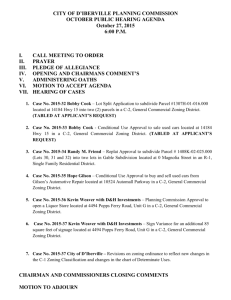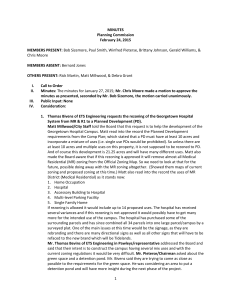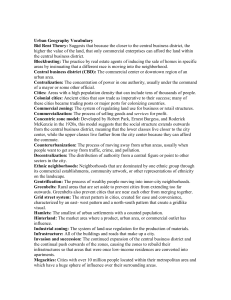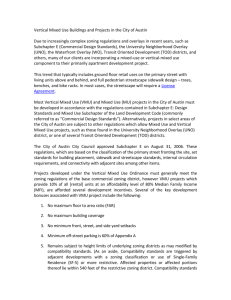City Planning
advertisement
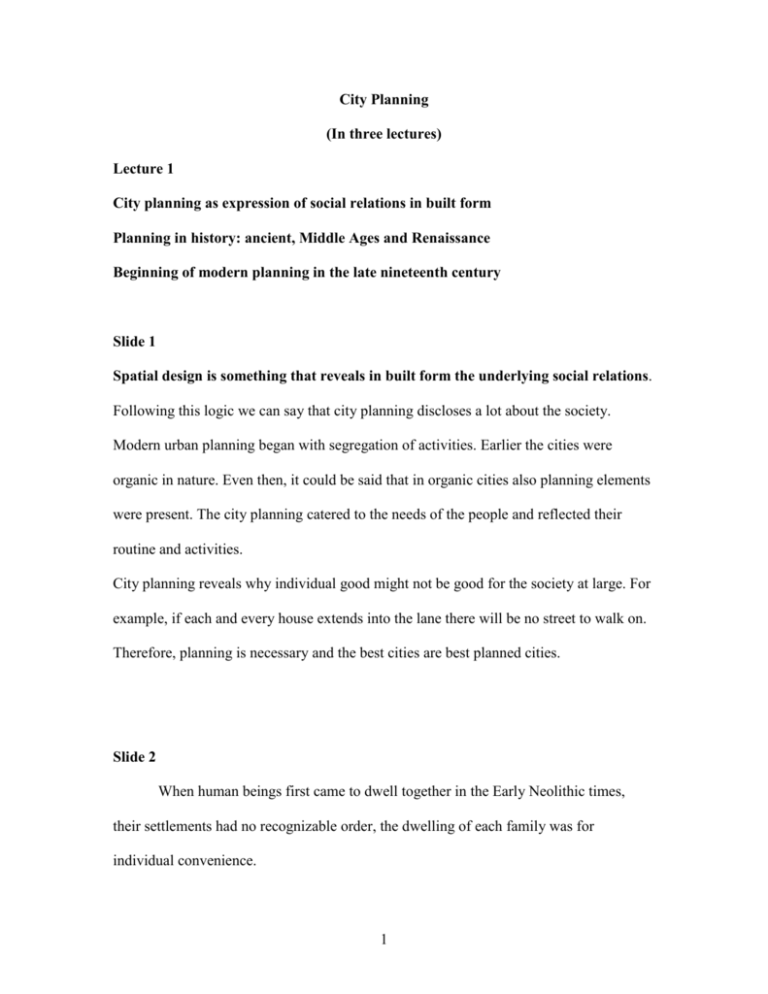
City Planning (In three lectures) Lecture 1 City planning as expression of social relations in built form Planning in history: ancient, Middle Ages and Renaissance Beginning of modern planning in the late nineteenth century Slide 1 Spatial design is something that reveals in built form the underlying social relations. Following this logic we can say that city planning discloses a lot about the society. Modern urban planning began with segregation of activities. Earlier the cities were organic in nature. Even then, it could be said that in organic cities also planning elements were present. The city planning catered to the needs of the people and reflected their routine and activities. City planning reveals why individual good might not be good for the society at large. For example, if each and every house extends into the lane there will be no street to walk on. Therefore, planning is necessary and the best cities are best planned cities. Slide 2 When human beings first came to dwell together in the Early Neolithic times, their settlements had no recognizable order, the dwelling of each family was for individual convenience. 1 One view was that the cities of ancient civilization were unplanned—their patterns arose as a result of spontaneous expression of the culture in which they arose. But others have pointed out that conscious designing was present in the ancient cities. Babylon and Kahun were planned cities of the 5th century BC. The cities of the Indus valley civilization (see lecture 5) were also well-planned. Most of these cities were constructed in the rectangular form similar to the modern gridiron pattern. A few were laid out in fan-shaped arteries. It is in the Roman Empire that we have more planned cities. The Romans often leveled uneven land to fit their plans but they also selected appropriate sites to which they fitted their plans. They made drainage and water their primary concern. Slide 3 Even during the ancient period some form of zoning was practiced that kept some industries outside the central areas and of controlling building heights. In Rome the height of buildings were limited first to 70 feet at the time of Augustus and later to 60 feet and subsequently to twice the street width by Nero. It has been pointed out that like all regulations these regulations were frequently disregarded! 2 During the Middle Ages there was very little building of cities in Europe. Smaller towns grew up. As the urban population grew, the constrictions caused by walls and fortifications led to overcrowding, the blocking out of air and light, and very poor sanitation. Irregularity was the common characteristic of medieval cities—in places, street lines and widths. Slide 4 During the Middle Ages whenever planning took place it was primarily for military protection. Thus a common feature of the medieval as well as of ancient cities was the circular roads following the lines of fortifications. And there were radial lines running from circular walls to the centre. But we can not assume patterns and planning in all quarters. The living conditions of the poorer citizens were disregarded in medieval times perhaps even more than in the Roman cities. Most streets were a little more than footpaths—more a medium for communication than for transportation—and even in major European cities paving was not widely introduced before the 12th century. When cities expanded beyond the wall the site was changed and new cities emerged about one days walk apart. Conscious attempts to plan cities reemerged in Europe during the Renaissance (14th to 17th century). Even during this era the aim was improving circulation and providing military defense and equally importantly the glorification of a ruler or a state. From the 16th century to the end of the 18th century many cities were laid out and built with monumental splendor. 3 The result may have pleased and inspired the citizens but it hardly contributed to their health, to the comfort of their homes or to the efficiency in manufacturing, distribution and marketing. Slide 5 Urban planning or the modern city planning movement had its origins in the reaction to the rapid and disorderly growth that characterized the latter part of the 19th century. One of the best known modern plans, the Chicago Plan began soon after 1900, was based on the desire for more order and beauty in one of most rapidly growing of modern cities. In America the European planning concepts were used but with modifications. More influential layout of the U.S. cities was the rigid grid plan of Philadelphia, designed by William Penn (1682). It is the simplest method of dividing up the surveyed territory which is easy to buy and sell. In most parts of the world city plans were based on the concept of a centrally located public space—secretariat, market and the business district. Gradually a comprehensive concept of city planning arose. Lecture 2 Growth of municipal consciousness Definition of city planning Academic discipline of urban planning City Beautiful Movement and the Garden City The New Town Movement The concept of ‘zoning’ Slide 1 City and town planning may be defined as the art of planning the physical development of urban communities with the general object of securing healthy and safe living and 4 working conditions providing efficient and convenient forms of circulation and advancing the general public welfare. Sometime before this new type of city planning had become prevalent or even recognized the legal foundation for its development had been laid in both USA and Europe. The growth of municipal consciousness to which this legislation owed its existence was the result of a reaction against the evils and abuses, especially in regard to sanitation, prevalent in most cities during the 19th century. Demand for improved sanitation and control of land development in the suburban areas of cities influenced the form of early city planning legislation. The growth of municipal functions has been especially evident in connection with such questions as the (i) control of building development, (ii) the increase of facilities for transit, (iii) the extension of water supply, (iv) the acquisition of land for public open spaces and (v) improvement of methods of sewage disposal. Slide 2 Now when did the modern discipline of Urban Planning come up? Modern urban planning as a scholarly discipline arose in the 1900s. In Great Britain the first academic planning programme began at the University of Liverpool in 1909, and the first North American Programme was established at Harvard University in 1924. 5 The lapse in planning which took place in the second half of the 19th century in America was a result of the development of the railroad, machinery and manufacturing. The surge of industry during this time was accompanied by rapid population growth, unfettered business enterprise, great speculative profits and public failures in managing the unwanted physical consequences of development. Giant sprawling cities developed during this era, exhibiting the luxuries of wealth and the meanness of poverty in sharp juxtaposition (Lecture :Friedrich Engels). Eventually the corruption and exploitation of the era gave rise to the Progressive Movement of which city planning formed a part. Slide 3 In later half of the 19th century the first housing reform measures were enacted. Such early regulatory laws set minimal standard for housing construction. Implementation occurred only slowly as government will was absent. The progressive era had also recognized the need for recreation. Parks, playgrounds were carved out in congested areas. Gradually games and sport facilities were created not only for children but also for adults. The grandeur of the European vision took root in the United States through the City Beautiful movement. The World’s Columbian Exposition of 1893, developed in Chicago according to principles set out by American architect Daniel Burnham became its central showpiece. The architectural style of the exposition established an ideal that many cities imitated. The archetype of the City Beautiful was characterized by grand malls and majestically sited civic buildings in Greco-Roman architecture and it was replicated in civic centres and boulevards, contrasting with and in protest against the surrounding disorder and ugliness. 6 Now while the “City Beautiful Movement” was especially influential on the European continent and in the design of American civic centres, it was the utopian concept of Garden City—first described by British social reformer Ebenezer Howard in his book Garden Cities of Tomorrow (1902) that shaped the appearance of residential areas in the US and Great Britain. Howard viewed the industrial city as simply too large. It had lost its human scale. He proposed, instead, that the new development follow a Garden City approach that melded factory construction with countryside living. The Garden City represented the best of city and country living. Slide 4 Howard’s approach gave rise to the new town movement in England which resulted in construction of factory centres located outside the large cities. The design was essentially based on a suburban form: (i) low-rise homes (ii) separation of commercial from residence (iii) plentiful open space lush with greenery. Howard called for a ‘cooperative commonwealth’ in which open land would be communally held and manufacturing and retail establishments would be clustered within a short distance of residence. Over a period of time, the successors abandoned Howard’s socialist ideals but held on to the residential design form. Ultimately the Garden City movement came to mean only suburban greenery. In other words, only the beauty aspect of his theory was retained without the social reform aspects. 7 Slide 5 It can not be said that any definite set of principles for city planning has yet been formulated. Discovering the economic, social and physical condition begins with the survey of the city. In the process of doing so it should deal with topographical conditions particularly in relation to industry, transportation, climatic and soil conditions and other natural features. Difference in city planning is the result not so much of the size but that of function, that is, whether they are industrial, business or recreational. The chief pitfalls in planning probably lie in two directions. The first of these is that of making city planning a mere branch of the real estate business and of seeking the stability of real estate values as its main objective. The second pitfall is the expenditure of money on extravagant improvements and on schemes of ornamentation of the city while public health and living condition is neglected. Slide 6 Zoning is a remedial technique which has been introduced in city for regulating unrestricted development. With rapid industrialization what was happening in the cities was factories were encroaching upon residential areas, skyscrapers overshadowed other buildings. Historically, the first steps in the direction of modern city planning can be traced to practices establishing districts within which certain rights of citizens were legally 8 curbed. During the late middle ages in Europe slaughterhouses were located on the outskirts of town so that offensive odors would not permeate the city. During the 1700s in Boston the segregation of the storage place for gunpowder away from the city centre was one of the first recorded acts of zoning the separation of social functions in separate land use districts. Activities that were public nuisance or menace were located in a less crowded area. Lecture 3 The technique of zoning The disadvantages of zoning Modernism in city planning after World War II Operation Research approach and its critiques Participatory Planning New Pluralism Slide 1 During the 20th century the technique of zoning became increasingly more important. Based on modernist principle that like activities should be located near one another and that manufacturing and residential functions should be separated, zoning partitioned land use according to each. Planners and policy makers perceived a need to sort out incompatible activities, set some limits upon building size, and protect areas from being spoilt. Zoning regulations first introduced in the early decades of the 20th century were the means for achieving these goals. Main purpose of zoning was segregation of particular uses of 9 urban space. Thus, housing, manufacturing and retail activities which formerly intermixed now took place in different parts of the city. 1 Slide 2 In the United States local planning in the form of zoning began with the 1916 NY city zoning law, but it was not until the Great Depression of the 1930s that the federal government intervened in matters of housing and land use. Although zoning had advantages it also leads to certain problems. It increased routine travel thereby contributing to traffic congestion. Some zoning codes provoked disputes such as single residence versus lower-income households. The planning of special economic zones (SEZ) is one type of exclusive spatial planning that has created serious social turmoil in many developing countries. Slide 3 Extensive planning took place during World War II and after the war also. The devastated cities of Europe were rebuilt through extensive rebuilding programmes. The principle was modernist—several high profile architects provided the guiding principle one of them was the Swiss architect Le Corbusier. The need was to produce large-scale relatively inexpensive projects and the architects’ preference and technologies that could be replicated universally. It was during this time that London was re-built. The Greater London plan was one such plan where a green-belt existed and construction of new towns beyond the 1 We can discuss the removal of polluting industries from the metropolis of Delhi. 10 greenbelt—lowering population density in the inner city, and the building of circumferential highways to divert traffic from the core.2 Slide 4 There have been competing models of urban planning and one approach has been Operation Research. This approach sought to find a universal method whereby experts would evaluate alternatives in relation to a specified set of goals and then choose the optimum solution. This scientific approach to public policy making was quickly challenged by critics who argued that the human consequences of planning decisions could not be neatly quantified and added up.3 Also under attack was the ‘Garden City’ and Le Corbusier’s ‘towers in the park’ approach. Jane Jacob, an urban analyst was one such critic. In her book The Death and Life of Great American Cities (1961) she criticized large scale clearance operations for destroying the complex social fabric and imposing an inhuman orderliness. Population density is not an evil but important for urban vitality. The argument here just like the sub-cultural theorists is that density and diversity are assets that makes city life vibrant. Slide 5 Participatory Planning By the end of the 20th century these arguments were being taken seriously. Instead of demolition, the emphasis became rehabilitation of existing buildings and 2 3 We can discuss the Ring road in Delhi. Discuss ‘abstract’ and ‘social’ spaces following Lefebvre. 11 neighbourhoods. The participatory mode became honoured in some cities. Involving the people—public participation signifies spreading and deepening of democracy. It is also seen that where government is authoritarian so is planning. For example, China in preparation for the Beijing Olympics of 2008 engaged in major displacement of its population to construct roads and sports facilities. The flip side of this participatory approach is that when all the ‘stakeholders’ are consulted rich people might veto and stall constructing affordable housing in fear that such construction will lower their property value. In the language of social movement theory this is known as “Not in My Backyard”( NIMBY).4 Slide 6 New Pluralism Universal principles regarding planning have increasingly broken down as a consequence of the move against ‘one plan fits all’. No standardized construction along modernist lines—now the planning opinion is in favour of being sensitive to local differences (that is where the sociologists come in) willingness to accept democratic inputs. Mismatch between desirable standard and resources available Many informal structures fulfill the needs of the people—street, market, slums difficult to eliminate in the name of progress. 4 Discuss relocation of toxic industries from the city to the outskirts. 12 Planning has its origin in the belief that a well-designed, comprehensively planned city would be a socially ameliorative one. It is ‘environmental determinism’. The goals of planning have subsequently become more modest and the belief that the physical environment can profoundly affect social behaviour has diminished. But it is a part of public policy and even though it does not radically alter human behaviour, contributes to the improvement in the quality of life for a great number of people. Slide 7 Reference: urban planning. (2011). In Encyclopædia Britannica. Retrieved from http://www.britannica.com/EBchecked/topic/619445/urban-planning 13


